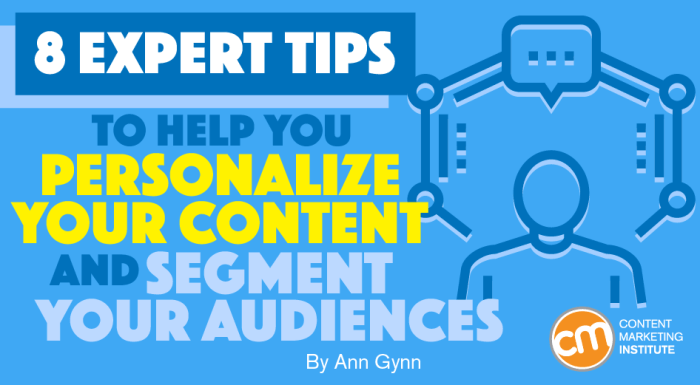Content Personalization Tips kick off this guide, setting the stage for a deep dive into transforming your online presence with tailored content that speaks directly to your audience. Get ready to level up your game with these expert insights!
Dive into the world of personalized content and discover the keys to creating a unique and engaging online experience for your users.
Importance of Content Personalization: Content Personalization Tips

Content personalization is crucial for businesses in today’s digital age, where consumers are bombarded with information from all directions. By tailoring content to individual preferences and behaviors, businesses can create a more personalized and engaging experience for their target audience.
Benefits of Implementing Content Personalization Strategies
- Increased customer engagement: Personalized content resonates more with customers, leading to higher engagement levels and increased brand loyalty.
- Improved conversion rates: By delivering relevant content to users based on their interests, businesses can drive more conversions and sales.
- Enhanced customer experience: Personalized content shows customers that a business understands their needs and preferences, leading to a more positive overall experience.
Examples of Successful Companies Utilizing Content Personalization
Amazon:
Amazon’s recommendation engine is a prime example of effective content personalization. By analyzing user behavior and purchase history, Amazon delivers personalized product recommendations that drive sales and enhance the shopping experience.
Netflix:
Netflix uses sophisticated algorithms to personalize content recommendations for each user, leading to increased user engagement and retention. By recommending shows and movies based on viewing history and preferences, Netflix keeps users coming back for more.
Spotify:
Spotify curates personalized playlists for users based on their listening habits, creating a more personalized music streaming experience. This level of customization keeps users engaged and loyal to the platform.
Strategies for Effective Content Personalization
To effectively personalize content, it is essential to utilize various strategies that help in collecting relevant data, creating targeted buyer personas, and implementing A/B testing to improve personalization strategies.
Different Methods for Collecting Data for Personalization
- Utilize website analytics tools to gather information on user behavior, preferences, and interests.
- Implement tracking cookies to track user interactions and personalize content based on their browsing history.
- Utilize surveys and feedback forms to gather direct input from users regarding their preferences and interests.
- Utilize social media listening tools to monitor conversations and trends related to your target audience.
Creating Buyer Personas for Targeted Content
- Collect demographic information such as age, gender, location, and income level to create detailed buyer personas.
- Consider psychographic factors such as interests, values, and lifestyle choices to further refine your buyer personas.
- Use data collected from customer interactions and feedback to create more accurate and detailed buyer personas.
- Regularly update and refine buyer personas based on new data and insights to ensure targeted content remains relevant.
Importance of A/B Testing in Personalization Strategies
A/B testing is crucial in personalization strategies as it allows marketers to test different variations of content to determine which one resonates best with their target audience. By analyzing the results of A/B tests, marketers can make data-driven decisions to optimize content personalization and improve engagement and conversion rates.
Implementing Personalization Across Different Channels

When it comes to personalizing content across different channels, it’s crucial to tailor your approach to each platform to ensure maximum engagement and impact.
Personalizing Email Marketing Campaigns
Email marketing is a powerful tool for reaching your audience directly. To personalize your email campaigns effectively, consider segmenting your email list based on demographics, behavior, or preferences. This allows you to send targeted content that resonates with each group.
- Use dynamic content to address subscribers by name and tailor the message to their interests.
- Implement personalized recommendations based on past purchases or website interactions.
- A/B test different subject lines and content to optimize engagement.
Personalizing Website Content for Visitors
Personalizing website content can enhance the user experience and drive conversions. By tracking user behavior and preferences, you can deliver relevant content to each visitor.
- Utilize cookies to remember past interactions and preferences of visitors.
- Create personalized landing pages based on referral sources or search s.
- Implement chatbots or live chat for personalized assistance and recommendations.
Personalizing Social Media Content for Different Audiences
Social media is a versatile platform for connecting with diverse audiences. To personalize your social media content effectively, consider the unique preferences and behaviors of each audience segment.
- Create audience personas to tailor content to specific demographics and interests.
- Engage with followers through comments, direct messages, and polls to understand their preferences.
- Utilize social listening tools to monitor conversations and trends, then tailor your content accordingly.
Leveraging Technology for Content Personalization
In today’s digital age, leveraging technology is essential for effective content personalization. Let’s dive into how AI, machine learning, personalization tools, and automation play a crucial role in this process.
Role of AI and Machine Learning, Content Personalization Tips
AI and machine learning algorithms analyze vast amounts of data to understand user behavior, preferences, and patterns. By leveraging these technologies, businesses can create personalized content recommendations tailored to each user’s interests and needs.
Use of Personalization Tools and Software
Personalization tools and software, such as customer relationship management (CRM) systems and content management systems (CMS), enable businesses to collect, analyze, and utilize customer data effectively. These tools help in segmenting audiences, creating personalized content, and delivering it at the right time through the right channels.
Best Practices for Implementing Automation
Implementing automation in content personalization requires careful planning and execution. Some best practices include setting clear goals, defining customer personas, testing and optimizing personalized content, and continuously monitoring performance metrics. Automation streamlines the personalization process, ensuring consistent and targeted content delivery across various touchpoints.
